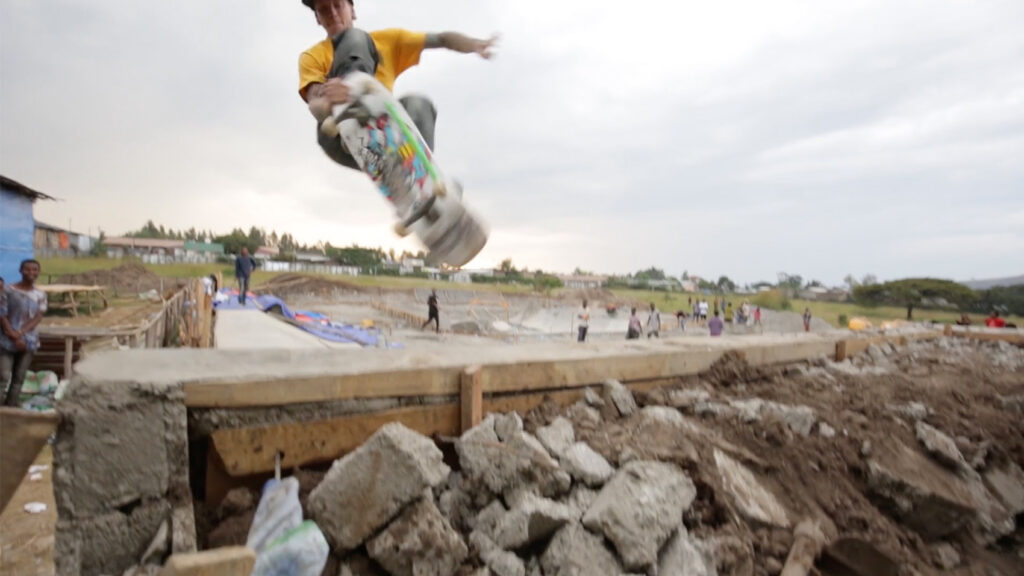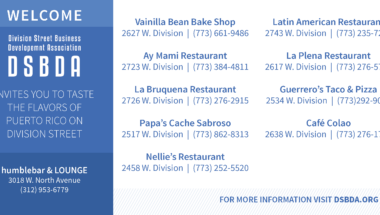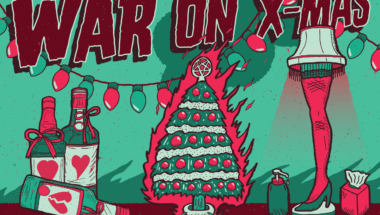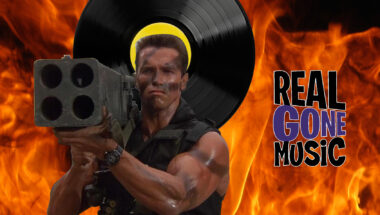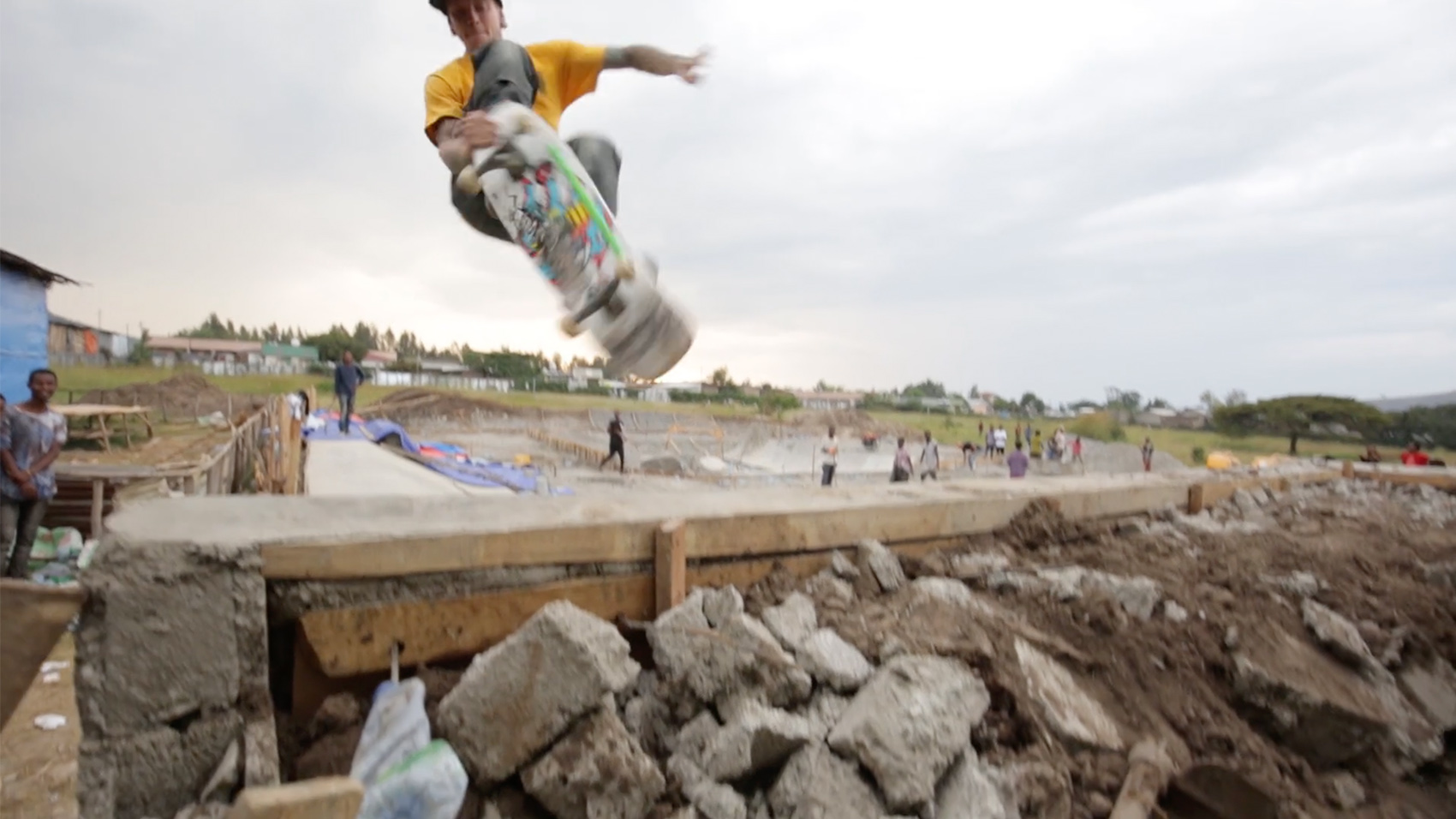
Skateboarding was a survival tool for Kody Oh. It gave him a sense of individuality, perseverance, and adaptability, as well as an outlet for what he terms “growing up hard.” And he’s far from alone. A great many skate enthusiasts came from difficult home environments. That said, very few have rededicated their lives to ambitious global humanitarian efforts, although the 36-year-old behind the nonprofit Go Future! Foundation encourages the would-be selfless to start small: “The idea of helping someone doesn’t have to be this grand gesture. It could be as simple as stopping and talking to somebody for a minute, giving them 10 bucks that you were going to use for something dumb anyways.”
Oh’s personal philosophy, however, is “go big or go home.” The former upright bassist/co-vocalist for “thrashicana” outfit the Calamity Cubes! may have cut his teeth fundraising for small-scale local projects in his native Kansas before moving on to the fight for clean water in Standing Rock, but after volunteering to help build Ethiopia’s second-ever skate park in Hawassa last fall, he launched Go Future!, whose first major endeavor is a skate park and community garden for the Puerto Rican Arts Center in the heavily populated Santurce district. Check out the GoFundMe for that project and read on about one punk rocker’s unyielding dedication to altruism.
RIOT FEST: Give me a little of your personal history. How did you find yourself in a position to devote so much time and energy to philanthropy?
KODY OH: I was a touring musician for years, which inevitably means you’re crashing on couches and kind of living on other people. I had to step away from that a couple years ago. In October of 2015, I was hospitalized during the listeria outbreak and almost died. We were getting ready to leave for tour, and that morning I had to go in and have surgery, and actually did flatline on the table; I had to heal during a 30-day tour, trying to recuperate from having a tumor cut out of me. I found that the best therapy was being able to step out of myself into a position of helping others. Through that, I just came to the point where I was like, “Well, you know, I’ve been dipping my toe in the waters of philanthropy and humanitarian efforts, so why not just dive head first into it?” Once you put your focus on where it needs to go, and it’s kind of where your true will lies, things just kind of fall into place for you.
What compelled you to volunteer in Ethiopia specifically? Were there other underserved nations on your wish list?
I heard about it from a friend of a friend. There’s an organization called Ethiopia Skate. I got a hold of them and said I wanted to come check it out. I don’t have extensive experience, but I’ve helped on a couple projects stateside. Inevitably, in skateboarding, you come to a point where you’re gonna build a jump ramp or, you know, grab a trowel and throw some concrete up against the barrier or something. Even before I went to Ethiopia and found out about that, I was talking to Danielle Colby [from American Pickers]; we ran into each other out in Hollywood. She does a lot of work with a nonprofit called Batey Girls in the Dominican Republic that takess women who are victims of sex trafficking off the streets — the organization fills a bunch of modular homes for these women and their children so they have a safe place to live, gives them jobs making jewelry, giving them living wages. So, we were talking about ways we can give back to the community, using our names and our status responsibly. I was asking, “What about the children?” I had been following other organizations like Skateistan, which has done a lot of work in Afghanistan and Cambodia and South Africa. I was really admiring what they did and figured, “What’s stopping me from trying that?”
What do people who haven’t paid attention to Ethiopia since Live Aid need to know about its development over the last 30 years?
I think there’s a lot of cultural misconception about a lot of African countries. It’d behoove a lot of people — especially a lot of people that have conservative ideologies and a harsher perspective of immigrants — to travel, see these places, and take away from the lessons that you learn from being someone who is completely alien to a society. Ethiopia is a highly agricultural country. They’re kind of closed off — they’re the only African country that has not been colonized — so through that, they’ve been able to preserve a lot of their culture and heritage. There are 82 different indigenous languages spoken in Ethiopia, and over 500 dialects that they’ve preserved for years. Christianity has existed since its inception, so has Islam, and they cohabitate harmoniously.
For some layperson’s perspective, what do high-end skate parks in the States cost compared to the Hawassa Skate Park that you helped build?
There are facilities that can run half a million dollars here. For a good quality-sized park, you’re looking at anywhere from 100 to 200 thousand dollars. While I’m not too sure of the cost [of Hawassa] — I wasn’t really involved in that aspect; I was just a volunteer in Ethiopia Skate — I would say [Hawassa] was considerably less. [laughs] But at the same time, materials there are just not as quality either.
What got these kids into skateboarding? Has anything as mainstream as, say, Tony Hawk filtered down to them?
It has, in a way. Skateboarding can be anywhere the internet is. Plus, there was a small movement in this town that was involved in skateboarding. Jimmy Carlos is kind of the person that brought the park to Ethiopia. He’s a skateboarder and a taekwondo instructor. We were there to build it for the masses, these street kids you see every day. I literally saw kids that were wearing the same clothes the entire time I was there. Now I’m starting to see pictures of them pop up at the skate park. It’s instilled them with that sense of ownership and pride in their community. They were there every day with us, man, carrying buckets of rocks and picking up hammers and driving in stakes and working concrete.
How long did the process take overall?
It was a little over a month to finish it. It was a pretty insane process. Everything was delivered by donkeys on carts — all our concrete, all our rebar. It was gnarly. Like, tools, if the handle broke, you just go cut a branch off and make another handle. The common saying down there is “T.I.A.”: “This is Africa.” You just make do with what you’ve got.
Hawassa Skatepark Build from Ethiopia Skate on Vimeo.
I would guess that, like a lot of skaters, you grew up on punk, metal, and hardcore. Did you get some perspective on what at-risk Ethiopian kids listen to?
It’s not like they really had a place or chance to listen to anything. A lot of the kids that were hanging out with us were street kids that were just running up and down the street, playing with each other, trying to get food. A lot of the music you hear is traditional, just whatever’s playing in the ambience. Although I did get exposed to some really cool Ethiopian jazz. Actually, there’s a hardcore scene there. It takes that traditional Ethiopian, northern African sound and adds that hardcore, fast element to it. It’s not like your typical pounding/yelling; it’s really intricate.
Once the Hawassa Skate Park was done, you got back to Kansas, at which point you founded Go Future!, right? Where do you stand as far as it being a fully established nonprofit?
It was something I was working on before Ethiopia. It was something I incepted with Danielle. Ethiopia Skate just happened to pop up at an opportune time for me to go and see the ground-level process of how this works, get a feel for what I was trying to do. After I got back, I started the process of the paperwork, which I’m still processing: getting the domain name, building the team I need to build for it. I’ve got my tax ID number, I’ve got a bank account, everything like that. Basically a bunch of money and a bunch of paperwork, which you have to do if you want to help people. [laughs] It’s funny how much bureaucracy and red tape goes into just trying to help others. I’m trying to get it done as fast as I can so it can be fully established.
Why make Puerto Rico the focus of Go Future!’s first GoFundMe campaign?
I’m trying to go back to Puerto Rico in April. My first trip was just preliminary, looking at areas that could benefit from a project. I found an orphanage that Danielle and her boyfriend Jeremy were working with through their organization for Puerto Rico, Happy Helpertons. It’s an orphanage/women’s shelter called La Casa de Todos. My first project when I go back in April is to build a temporary mini-ramp and a couple obstacles for the kids. They have blueprints for a renovation plan — they’re trying to rebuild the orphanage because there are a lot of buildings that really could use an upgrade. Once that gets underway, we’re asking to build playgrounds, as well as a permanent skate area for the kids. What I’m trying to do to differentiate myself from organizations that are building skate parks in underserved communities is add an element of more than pride and ownership. Seeing the kids in Ethiopia interacting with us and being part of the building process, seeing the confidence they got from that, I want to take that a step further. One of my other projects I’m talking about with people in Puerto Rico is building skate parks that have community garden aspects incorporated into the design. Like vertical beds on the backs of some of the vert walls. So that way, you can do vertical gardens on the back. You could have planters with fruits and vegetable growing. Not only does it incorporate these elements of ownership for the kids, it also gives them a sense of responsibility to their community.
How advanced are these kids skill-wise?
Ethiopia is so incredible. The exponential rate of progress in skateboarding is amazing. They have very limited access to skateboarding. This one kid — they built a park in the capital, Addis Ababa; that was the first park they built in Ethiopia — he skates in sandals, doesn’t even know how to, like, pop an ollie, but he’s doing blunt to fakies on vert wall. They gather what they’re exposed to, and they’re just going with it.
Puerto Rico has a lot more exposure, being a U.S. territory. There’s a pretty prevalent skate scene there already. There’s a DIY bowl in an area called La Perla in San Juan that a local named Chemi [Rosado-Seijo], he and his buddies built it on their own. There are several pros that have come out of Puerto Rico. That’s why I’m focusing on areas that are kind of cut off or a little more removed. Like the orphanage in Juncos-Juncos is up in the mountains. I’m talking to another spot in Adjuntas, an agricultural school and cultural center up in the mountains. I’m trying to bring it to places where the access is limited.
What is it about your relationship with skating that inspired you to make it your main form of charitable outreach?
Some of the best kids you see in skateboarding are the kids who came from the worst environment… because that’s all they had. That was their tool. It was their way of getting through. It was the ultimate passport. It’s taken me everywhere. It’s given me strength and resilience and passion. You take a skateboard to anybody in the world, come back in a year, and their whole perspective has shifted. If I didn’t have skateboarding, I wouldn’t be here right now. That’s why I feel it’s almost incumbent upon me to pass it on to other people that could really benefit from these attributes that are second nature to skateboarding.
